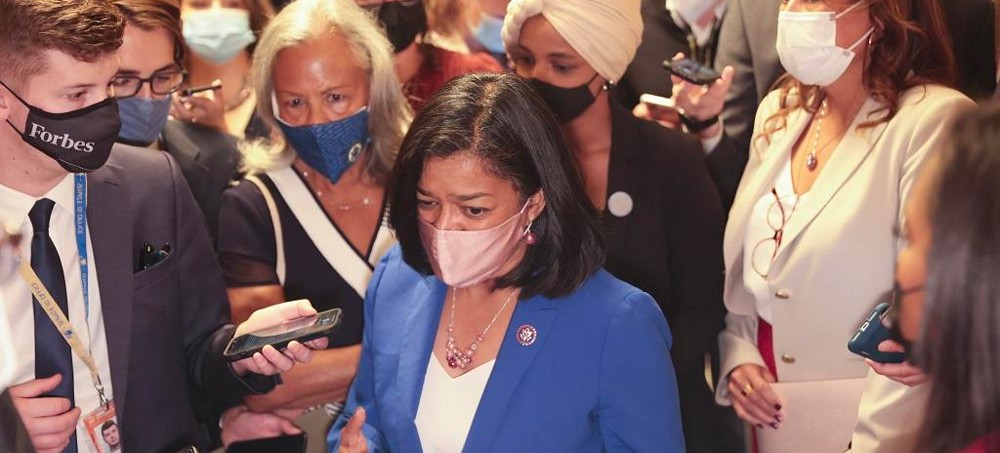Live on the homepage now!
Reader Supported News
For generations there have been progressive voices in US Congress. One here, two there calling for reason and purpose. Always outnumbered, always marginalized.
All of that began to change at the turn of the 21st century. The advent of internet communications allowed average Americans to compare what they believed to what they were hearing through the main stream media.
The second quantum leap came with Bernie Sanders 2016 presidential campaign and the little noticed but revolutionary, game changing organizing efforts that followed. Not just organizing voters but organizing an entire generation of young Progressive political leaders. Against that backdrop this current drama now plays out.
The People On the Plane and the Hijackers
Between the House and the Senate there are 270 elected Democrats serving in Congress today. 268 of those Democrats are prepared to vote yes on both infrastructure bills, now. 2 are not. 2 members are taking control of the agenda from 268. That makes the 268, the people on the plane and the 2, the hijackers. Stick a pin in that.
Not What Will Be Spent, Who Will Pay
The amount of proposed spending is said to be the sticking point with the “moderates.” That’s a colossal red herring of epic proportions. The problem isn’t what will be spent, it’s who will pay for it. That is where the opposition to the larger social spending really lies. The larger 3.5 trillion dollar spending bill calls for tax increases on the wealthiest Americans by a few percentage points. That and stepped up enforcement of tax laws that already exist. That is why corporate friendly Democrats are risking their careers and the country’s future to stand in oposition to virtually their entire caucus.
The Cost to Average Taxpayers is effectively Zero
The 3.5 trillion dollar package calls for no tax increases on lower and middle income taxpayers. But it pays huge dividends in terms of the economic infrastructure working Americans depend on and will be able to rely on for generations to come.
Corporate Media Coverage
The media oracles owned by Fortune 500 corporations describing the Capitol Hill infrastructure battle choose to depict it as essentially an equally divided Democratic party in which neither side wants to be reasonable and compromise. Of course those who oppose the 3.5 trillion dollar package are labeled “moderates” and “centrists.” There’s a reason for that. The companies that own those the large media outlets will be asked to pay more in taxes. That doesn’t sit well in the boardrooms.
In generations past this battle would already be over. These are not the Reagan years, the Clinton years, the Bush years or even the Obama years these are the Biden-Sanders years and the balance of power in our nation’s Capitol has fundamentally changed.
The progressives are marginalized no longer. Now they are the true centrists by virtue of their sheer numbers. When Pramila Jayapal Chair of the Congressional Progressive Caucus enters a negotiation she enters with a block of not 2 or 10 votes she enters with 60 or more votes in tow. The Manchin crowd understood how to move their purple state colleagues, the Speaker and the President but they can’t move the largest cohesive caucus in US congress, the Progressive caucus. That’s game-changing, country-changing power.
This is not just a budget battle, it’s an historic shift in the power balance on Capitol Hill. The center has shifted. The progressives have made their case not only with Progressive voters but with voters long defined as Conservative. Not on Capitol Street, but on Main Street where it really matters. As a result a growing number of American voters are beginning to understand how deeply good policies can effect their lives and who will and will not vote for those policies.
The Progressives are holding the line, because for the first time in the history of American governance, they can. The tide is turning. The changes are long overdue.
Marc Ash is the founder and former Executive Director of Truthout, and is now founder and Editor of Reader Supported News.
Reader Supported News is the Publication of Origin for this work. Permission to republish is freely granted with credit and a link back to Reader Supported News.
 A police officer. (photo: Adobe Stock)
A police officer. (photo: Adobe Stock)
In an article published Thursday in the medical journal The Lancet, researchers found that deaths from police violence between 1980 and 2018 were misclassified by 55.5% in the U.S. National Vital Statistics System, which tracks information from death certificates.
"For most causes of death, the death certificate filled out by a physician is sort of the gold standard," says Chris Murray of the Institute for Health Metrics and Evaluation at the University of Washington, who is one of the study's authors. But he says that in this area, the certificates seem to fall short. "There is a pretty systematic underrecording of police violence deaths. "
That realization isn't entirely new. After the 2014 shooting of Michael Brown in Ferguson, Mo., news organizations started to keep their own tallies of police-related deaths, which turned out to be higher than the government's numbers.
What Murray and his co-authors have done, though, is measure the discrepancy between independent tallies and the government data, and project it back in time.
"We've used those relationships of what fraction get underreported to go back and infer, for example, in the 1980s, what was the likely number of police violence deaths," Murray says.
The researchers based their inferences on numbers from three open-source databases: Fatal Encounters, Mapping Police Violence and The Guardian's The Counted, which they compared with the data from the death certificates.
They calculate that the death certificates misclassified the cause of death on more than 17,000 such deaths since 1980.
"If it's legit, it's pretty cool how they can take existing data from a short time frame and work backwards," says Justin Nix, associate professor of criminology at the University of Nebraska.
But as a criminologist who studies shootings by police, Nix has reservations about the underlying data.
"My concerns with this paper are the same as many that use these crowd-sourced databases," he says. He has documented cases where the databases count, for example, domestic violence by off-duty officers as police killings.
"I'm not saying we don't need to track that in these sorts of databases, but I'm just saying that all police killings are not created equally," he says.
"I think there's definitely issues around exactly the criteria used," says the IHME's Murray. "I think that's an important question, given that we're looking at multiple sources. [But] I don't think it's really influencing the time-trend we're seeing. In other words, the numbers are going up, regardless."
The study shows the death rate in these encounters dropping in the 1980s, then generally rising again since about 2000.
The article also highlights the disparity in the mortality rate for African-Americans, which it says is 3.5 times higher than that of whites.
The article suggests the disparity is caused by "systemic racism in policing," but it doesn't specify how that happens. Specifically, it doesn't address whether police are more likely to use lethal force against African-Americans or whether nonpolicing factors lead African-Americans to have more encounters with police.
Murray says this analysis doesn't answer that.
"I don't think from a scientific point of view, we have enough information here to parse out how much of this is, you know, basic differences in where people live, what sort of disadvantage they have, versus the actual specific actions of the police," he says.
But as a public health expert, Murray says the more we know about these deaths, the easier it will be to find policy solutions.
"It's the old saw: You manage what you measure. And so we've got to do a better job of tracking in what's actually happening," he says.
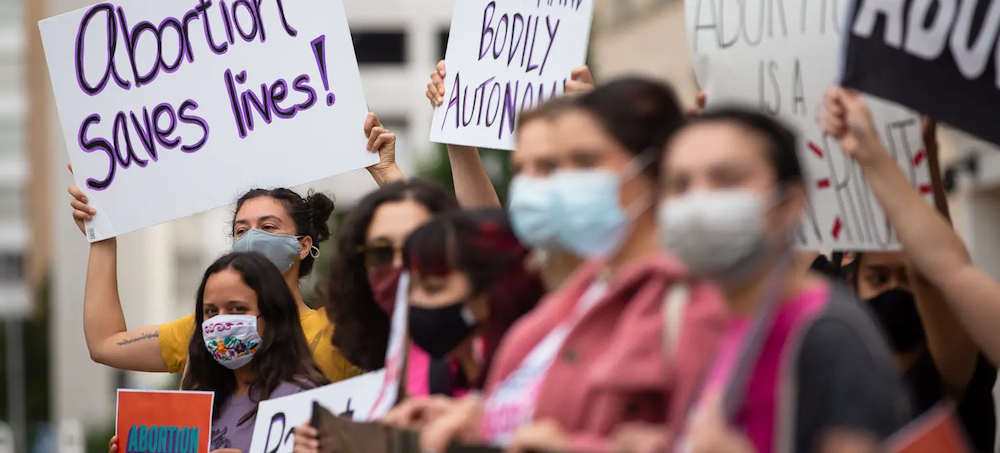 Demonstrators protest anti-abortion laws in front of the Governor's Mansion in Austin, Texas. (photo: Evan L'Roy/The Texas Tribune)
Demonstrators protest anti-abortion laws in front of the Governor's Mansion in Austin, Texas. (photo: Evan L'Roy/The Texas Tribune)
The controversial statute, which went into force on September 1, represents "an open threat to the rule of law," deputy assistant attorney general Brian Netter declared in court arguments in Austin.
In its challenge, the US government described the ban as "a truly extraordinary law designed to outflank the federal government and to violate the constitution," Netter said, adding a "judicial intervention" was necessary to make the law unenforceable until the case is decided.
The Texas law, the most restrictive of its kind in the country, prohibits abortions as soon as an embryo's heartbeat is detectable, usually at around six weeks of pregnancy, and does not allow exceptions in cases of incest or rape.
In recent years similar laws have been passed in other states but were struck down because they violated US Supreme Court precedent from Roe v. Wade, the 1973 ruling which guaranteed a woman's right to an abortion until the fetus is viable outside the womb, at around 22 weeks of pregnancy.
The Texas law is unique in that it empowers anyone to file lawsuits against a person who has assisted in an abortion, which prompted Netter to accuse state authorities of enabling a regime of "vigilante justice."
The nine-justice Supreme Court, with its clear conservative majority, cited such "novel" procedural issues when it decided last month against intervening to block the law, Texas Senate Bill 8, as pro-choice advocates had requested.
The federal government has entered the fray, citing its interest in upholding Americans' constitutional rights.
Netter argued that while the United States rarely files suit to challenge state laws, "this suit is necessary because SB-8 represents a thus far unprecedented attack on the supremacy of the federal government, of the federal constitution."
Attorney William Thompson of the Texas Attorney General's Office accused Netter of "inflammatory rhetoric" and insisted the law respects Supreme Court precedent.
But Judge Robert Pitman retorted: "If the state's so confident in the constitutionality of the limitations on a woman's access to abortion, then why did it go to such great lengths to create this very unusual private cause of action?"
Pitman could issue a ruling soon in the case.
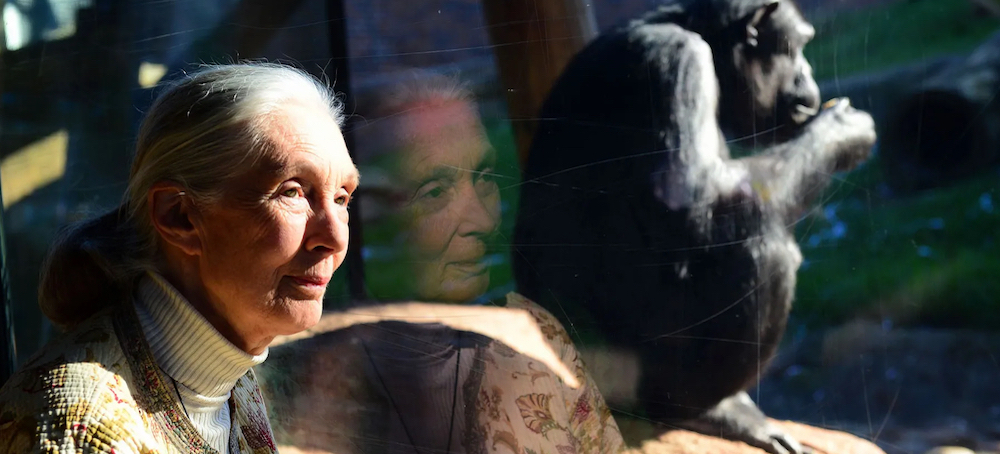 British primatologist Jane Goodall at the chimpanzee enclosure at Australia's Taronga Zoo. (photo: Jeremy Piper/Newspix/Getty Images)
British primatologist Jane Goodall at the chimpanzee enclosure at Australia's Taronga Zoo. (photo: Jeremy Piper/Newspix/Getty Images)
The eighty-seven-year-old naturalist knocks around her home on the south coast of England and explains why, despite the floods and fires and melting ice caps, she’s still optimistic about planet Earth.
She does, and she’ll tell you why. “The Book of Hope,” which she wrote with Douglas Abrams and Gail Hudson, is structured like a dialogue in which the naturalist (Ph.D., D.B.E., U.N. Messenger of Peace) plays whack-a-mole with the darkest fears we hold for our ailing planet. Stories of the human intellect and indomitable spirit abound. Also, the resilience of nature and the power of young people. Hope, she argues, is not merely “passive wishful thinking” but a “crucial survival trait.” She noted, “If you don’t have hope that your action is going to make a difference, why bother to do anything? You just become a zombie.”
Goodall was seated on a sofa in the drawing room of her childhood home, in Bournemouth, on the south coast of England. She had her hair in a ponytail and was wearing a Patagonia jacket with jeans, moccasins, and whale-print socks. Shuttered in the house since the outbreak began, Goodall has adopted a relentless schedule of online engagements, Zooming to multiple countries each day. “Virtual Jane has been busier than ever,” she said. “It’s hurting my voice, my eyes.” She has not taken a day off in a year and a half; she Zoomed twice on Christmas, launched a podcast called “The Hopecast,” and, in May, accepted the Templeton Prize (previous recipients include Mother Teresa and the Dalai Lama). “But the pluses!” she said. “I’ve reached literally millions more people in many more countries. I was in Tanzania this morning, and then I was in the Netherlands for an interview. Or is it Belgium?”
Goodall was sharing the Gothic-style house (built in 1872) with her sister, Judy, Judy’s daughter and grandchildren, and an aging rescue whippet named Bean. It’s not the first time the family has taken refuge there. “It was my grandmother’s,” she said. “Mum and Judy and I came here when the war broke out. World War Two.” In the garden, butterflies flitted by; Bean was asleep in an armchair. Growing up, there were always animals around, she said. Dogs, cats, “a couple of tortoises.” “Peter the canary, who used to fly around the whole house. Hamlet the hamster, who escaped and spent the rest of her life in the back of the sofa, coming out at night for food.”
In 1960, at the age of twenty-six, Goodall left England for Gombe National Park, in Tanzania, to study animals in the wild. She took her mother with her. (“Mum played a very important role.”) It was in Gombe that Goodall almost lost hope. She was up at dawn every morning, crawling through the forest with binoculars, looking for chimps. She would return to camp unsuccessful and depressed. Finally, a chimpanzee she called David Greybeard (“very handsome”) let her observe him using grass stems to collect termites, the report of which prompted Goodall’s mentor to send an exuberant telegram: “Ah! We must now redefine man, redefine tools, or accept chimpanzees as human!”
In the drawing room, Goodall checked the time: fifteen minutes until she needed to record a message for French university students. She poured herself a drop of whiskey. “When my voice goes like this, it’s the only thing that works,” she said. (It was a lifesaver when she had bronchitis at Davos.) Did she ever get tired? “I care about the future, I care about animals, I care about trees, I care about children,” she said. “And I’m obstinate and I won’t give in. I won’t be defeated by the Bushes, and the Putins, and the Bolsonaros, all these terrible, terrible people.”
Lately, Goodall has been working from an attic bedroom surrounded by objects that give her hope: a photograph of David Greybeard, a Native American talking stick, a bell made from a defused land mine. She climbed the stairs slowly, held up the bell, and rang it. “Special,” she said. She checked the time again. The French students beckoned.
 'For years, despite athletes generating oodles of money for their schools without compensation, the NCAA has fought off every attempt to organize athletes.' (photo: Damian Strohmeyer/Sports Illustrated)
'For years, despite athletes generating oodles of money for their schools without compensation, the NCAA has fought off every attempt to organize athletes.' (photo: Damian Strohmeyer/Sports Illustrated)
In a landmark memo this week, the National Labor Relations Board ruled that athletes at private colleges are workers with the right to negotiate and unionize. Maybe the tide is finally turning against the NCAA's feudal-like conditions.
Abruzzo’s memo effectively reinstates a 2017 document issued by Barack Obama–appointed general counsel Richard Griffin — and rolled back under Donald Trump — but her memo goes further than Griffin’s. It’s a huge win for athletes hoping to unionize and for the broader cause of labor rights in the United States.
For years, despite athletes generating oodles of money for their schools without compensation, the National Collegiate Athletic Association (NCAA) has fought off every attempt to organize athletes. But even before this week’s decision, the cracks were forming.
In 2014, the National Labor Relations Board in Chicago ruled that football players at Northwestern University were employees that could unionize. The NCAA appealed the ruling, and the NLRB ultimately rejected the athletes’ petition while sidestepping the compensation issue.
“We emphasize that this case involves novel and unique circumstances,” the decision read. “The Board has never before been asked to assert jurisdiction in a case involving college football players, or college athletes of any kind. There has never been a petition for representation before the Board in a unit of a single college team or, for that matter, a group of college teams. And the scholarship players do not fit into any analytical framework that the Board has used in cases involving other types of students or athletes.”
That same year US District Judge Claudia Wilken ruled that the NCAA was violating antitrust law by prohibiting athletes from profiting off their Name, Image, and Likeness (NIL). Her decision came in response to a 2009 lawsuit that was filed against the NCAA by Ed O’Bannon, a basketball star at UCLA during the 1990s. O’Bannon, the key player in UCLA’s 1995 championship run, launched his legal challenge after recognizing himself and the rest of the title team in a video game.
The NCAA appealed Wilken’s ruling, and the Ninth Circuit issued a decision that favored the college sports league. While the court agreed with Wilken’s view that the compensation rules were unlawful, it insisted that the NCAA had to “maintain its tradition of amateurism in support of the college sports market.” Schools could provide up to the cost of attendance to athletes, but nothing more.
This year, the cracks began to widen again. First, the Supreme Court upheld lower court rulings in US vs. Alston, eliminating the limits that players can obtain from NIL. The concurring opinion was written by Justice Brett Kavanaugh of all people. “Nowhere else in America can businesses get away with agreeing not to pay their workers a fair market rate on the theory that their product is defined by not paying their workers a fair market rate,” he wrote. “And under ordinary principles of antitrust law, it is not evident why college sports should be any different. The NCAA is not above the law.”
Days after the SCOTUS ruling in June, Judge Wilken was back in the news — this time for denying yet another request from the NCAA to have a lawsuit thrown out. This one, filed by Arizona State swimmer Grant House and Oregon women’s basketball player Sedona Price, doesn’t just target the restrictions on NIL compensation. It also argues that athletes are potentially entitled to a cut of the television-rights money.
By the end of the month, the NCAA had changed its rules to allow athletes to engage in NIL activities in accordance with their state laws. A number of states have already legalized such transactions.
But Abruzzo’s historic memo might later be viewed as the crucial crack in the NCAA’s feudal-like edifice. The NLRB’s regional offices are guided by the general counsel, and schools looking to union-bust are now aware they’re being watched closely. And while the document only applies to private schools, it could potentially impact public universities as well, since both compete against each other.
In fact, Abruzzo’s memo declares that “similarly situated players at academic institutions” are also employees and cites the College Athlete Right to Organize Act, a bill introduced earlier this year by Senators Bernie Sanders and Chris Murphy. “College athletes are workers,” Sanders said after introducing the legislation. “They deserve pay, a union, and to own their own name, image, and likeness. We cannot wait for the NCAA to share its billions with the workers who create it. It is long past time we gave these workers the rights they deserve.”
In 2018, Ed O’Bannon talked to Sports Illustrated about his fight. “At that age, you do as you’re told,” he explained. “You don’t ruffle any feathers. You’re told that the position that you’re in is one that you can’t mess up, or don’t take for granted. You’re a kid and you keep your mouth shut, you keep your head down and you work hard. You’re best seen and not heard from. When you’re in the throes of it all as an athlete, you see it and recognize it and you even talk about it with your classmates and your teammates. But there isn’t a whole lot you can do because there’s no representation.”
This week’s NLRB memo might very well change that.
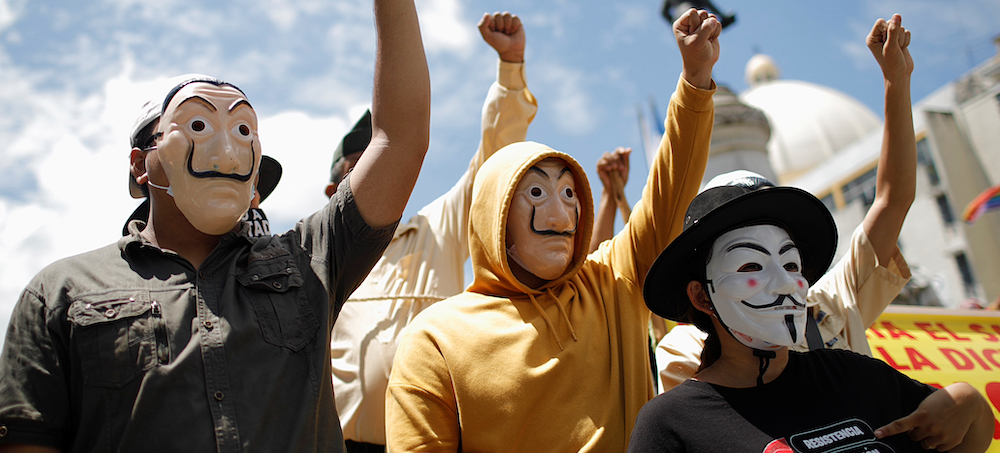 People participate in a protest against the use of Bitcoin as legal tender and legal reforms to extend president Nayib Bukele's term in San Salvador, El Salvador. (photo: Jose Cabezas/Reuters)
People participate in a protest against the use of Bitcoin as legal tender and legal reforms to extend president Nayib Bukele's term in San Salvador, El Salvador. (photo: Jose Cabezas/Reuters)
The selective "purge" of judges and his economic policies unleashed the outrage of the citizens.
The protest began in the "Savior of the World" Square in Salvador city. From there, citizens tried to reach the Legislative Assembly headquarters. However, Police forces established a security perimeter around the building to prevent protesters from entering the area.
In September, Congress approved a legal reform allowing judges who are over 60 years of age or have 30 years of service to be removed from office. This provision would allow the Bukele administration to dismiss one-third of the country's judges.
Over the last weeks, Over the past few weeks, 100 judges voluntarily resigned in order to receive compensation, 34 magistrates were dismissed without benefits because they refused to resign, and 115 judges applied for the "stay on call" regime, which is an alternative contemplated in the new rule.
"Judges' rights have been violated... we asked the Inter-American Commission on Human Rights (IACHR) to pronounce against this outrage," said Judge Juan Antonio Duran.
Hundreds of veterans of the Salvadoran civil war (1980-1992) also joined the march. They demanded Bukele to honor the promises he made during his electoral campaign. These included higher pensions and scholarships for the children of former combatants, both from the Armed Forces and the Farabundo Marti National Liberation Front (FMLN).
Another reason why Salvadorans protested is the imposition of Bitcoin as legal tender.Citizens claim that this cryptocurrency will make them lose their purchasing power.
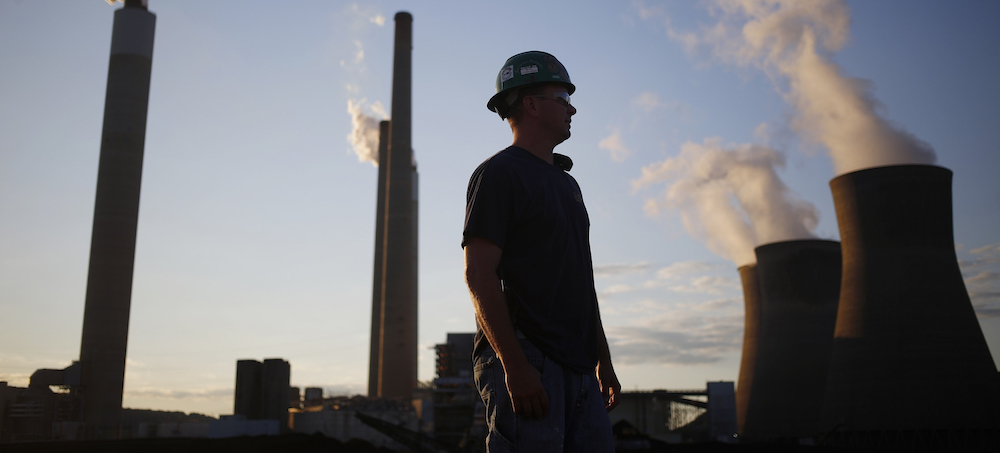 A worker stands in a coal yard in Winfield, West Virginia. (photo: Luke Sharrett/Getty Images)
A worker stands in a coal yard in Winfield, West Virginia. (photo: Luke Sharrett/Getty Images)
“For a long time, the culture here has been ‘What’s good for coal is good for West Virginia,’” one expert said. “But that hasn’t been true for 10 years, or decades longer.”
His father and grandfather were coal miners. Coal meant a roof over their heads and a tie to bind the small community of Wilsondale that they called home. People there found purpose in coal, proud to know their work was helping power the nation.
But Hannah, 29, also saw neighbors who grappled with nasty illnesses: bronchitis, black lung and cancer. Worksite injuries were a constant. And he began to hear more news about climate change and the role that coal and other fossil fuels played.
“The coal economy is a sinking ship,” he said, “but it’s difficult for anyone who grew up in Appalachia not to feel a sense of defensiveness and protectiveness towards coal.”
Hannah is a conservation coordinator for Coalfield Development, a nonprofit group working to revitalize West Virginia, in part through clean energy. The organization recently put in place the state’s largest nonprofit solar installation. He’s proud of his family’s legacy but traveling around the state and taking stock of shuttered storefronts and scarred land have convinced him that the need for change is clear.
“We need an antidote,” he said. “We need medicine to strengthen our communities.”
At a time when U.S. leaders are finally moving to address climate change, it’s fitting that a state long at center stage in America’s resource-extraction economy would hold the spotlight.
Since the start of Joe Biden’s presidency, all eyes have been on Sen. Joe Manchin, D-W.Va., whose vote in an evenly divided Senate positions him as a linchpin in the federal climate agenda. Prior to entering politics, Manchin founded and ran the coal-brokerage firm Enersystems. He handed the company to his son upon being elected West Virginia’s secretary of state in 2000 — he served later as governor, before joining the U.S. Senate in 2010 — but retained millions in company stocks. According to the senator’s financial disclosures, Manchin continues to earn hundreds of thousands each year from the sale of coal.
To date, the centrist Democrat has been critical of the action that scientists around the world agree is necessary to avoid the worst of the climate emergency. He argues that a rapid move toward clean energy could sound the death knell for communities already suffering from fossil fuels’ decline.
In Manchin’s home state, however, some say change can’t come soon enough. Coal remains a backbone of some West Virginia communities. But with a nationwide shift toward renewables underway, many West Virginians are eager to secure a place for the state in America’s clean energy future.
“For a long time, the culture here has been, ‘What’s good for coal is good for West Virginia,’” said James Van Nostrand, director of the Center for Energy and Sustainable Development at the West Virginia University College of Law. “But that hasn’t been true for 10 years, or decades longer.”
In the mid-1900s, coal employed more than 100,000 people in the Mountain State. Over the years, new technology enabled companies to mine more with fewer workers. Then, beginning in the mid-2000s, the shale revolution saw natural gas challenge and ultimately, in 2016, replace coal as America’s leading energy source for electricity production. In 2019, the last year for which data is available from the U.S. Energy Information Administration, coal employment in West Virginia was down to roughly 14,000.
Throughout this decline, poverty spiked, placing West Virginia consistently among the poorest states in the country. The state has also come to lead the nation in population decline, with young West Virginians increasingly leaving to find gainful employment. A grim joke in the state goes that people have overtaken coal as West Virginia’s top export.
In a state prized for its natural beauty, the environmental situation is no better. Abandoned mines and thousands of uncapped oil and gas wells pollute local air and water. Mountaintop removal, a mining practice that involves deforesting mountain peaks and then blasting them out of existence to get at coal underneath, continues to cover surrounding areas in hazardous dust.
Health impacts are widespread, and in Charleston, the state capital, deregulation is standard. Many political leaders in West Virginia have direct ties to the coal industry, including Gov. Jim Justice, a Republican and a billionaire who owns multiple coal companies and, in his official capacity, oversees the state regulatory arms meant to hold those companies accountable.
“It’s not uncommon for me to turn on the tap water, and it’s brown,” said Angie Rosser, director of the environmental nonprofit West Virginia Rivers Coalition. “That’s normal in many parts of West Virginia. Some of us don’t remember ever having safe water.”
Further emphasizing West Virginia’s legacy as a fossil fuel producer, climate change is also taking a toll.
Rosser, like many West Virginians, lives near a river. In June 2016, torrential rains filled the Elk River outside her home, triggering a flash flood. That day, floods killed 23 people and devastated much of central West Virginia. She said her town, Clendenin, hasn’t been the same since.
“People have left," she said. "There are abandoned houses. We still don’t have a grocery store.”
Scientists called the flooding a “thousand-year event” but only a preview of what climate change might have in store for West Virginia. As global heating progresses, the Appalachian region is projected to become significantly wetter, with heavier rainfall making floods both more likely and more dangerous.
Traditionally, climate change has been a near-verboten subject in her state, Rosser said. The implicit threat to coal was always one thing. In a deeply conservative state, the politicization of climate change was another. A 2020 study by Yale University and George Mason University showed that fewer people in West Virginia believed climate change was occurring than in any other state — 59 percent of adults compared with 72 percent nationwide.
Affinities toward coal notwithstanding, she said it’s clear that West Virginians’ foremost loyalties lie with their families and preserving the state as a safe and prosperous place to call home.
“I’m hearing more conversations acknowledging that coal isn’t coming back,” Rosser said. “There’s a lot of fear and anxiety actually that maybe we waited too long.”
Increasingly, a transition away from coal might be a conversation some West Virginians are willing to entertain.
Along with other local nonprofit group, Rosser’s organization recently produced a “Citizens Guide to Climate Change.” Written “by West Virginians, for West Virginians,” she said, the guide aims to push climate discourse in the state forward, unpacking the causes and impacts of climate change from a local perspective and laying out a menu of potential solutions, such as a Green New Deal, enhanced emissions regulations and a carbon tax.
Rosser expected skepticism, but responses to the guide have been positive, she said. Especially resonant is the goal of a “just transition,” which suggests that, although fossil fuels are very much to blame for climate change, a special debt is owed to fossil fuel workers, as the nation shifts to new sources of energy.
“We put in the work to lift America into an industrialized power, through the use of coal,” Rosser explained. “Now, we deserve reinvestment.”
And West Virginia is ripe for reinvestment, according to Jeremy Richardson, a native West Virginian and a senior analyst with the Union of Concerned Scientists’ Climate and Energy program. There is “plenty of untapped potential,” he said, to create jobs as an “off-ramp” for current and former coal workers — first, in reclaiming and restoring land damaged by fossil fuel exploitation and, second, in domestic manufacturing of clean energy components, such as windmill blades and parts for solar panels. West Virginia is also well-suited to wind and solar energy production.
Clean energy is unlikely to replace every coal and fossil fuel job lost in West Virginia, he added. But it can help begin to diversify the state’s economy. It will also make West Virginia more attractive to outside industries and companies, such as car manufacturers — which increasingly have made their own climate commitments and, thus, are unlikely to invest where clean energy is scarce — sparking further economic development.
“West Virginia is behind the eight ball, because we haven’t done a lot by way of developing and deploying clean energy,” Richardson said. “We really need to go far fast.”
Whether West Virginians will reap the benefits of clean energy opportunities depends in large part on the state’s leaders in both Charleston and Washington, said Van Nostrand, of West Virginia University. In this regard, there have been halting gestures toward sustainability, he added, but the state lags behind most others, as well as the latest climate science. In August, a landmark United Nations report warned that the consequences of climate change, including the extreme weather wreaking havoc already, will grow dramatically worse this century if humanity fails to rein in emissions.
Also critical: making sure climate action reaches communities of color in West Virginia. The state is more than 90 percent white, but African Americans nevertheless comprised a substantial portion of the coal labor force, said Pam Nixon, a community organizer with the Charleston, West Virginia, chapter of the NAACP.
As technology in the industry progressed, though, Black workers typically weren’t selected for training opportunities; when layoffs became commonplace, they were far more likely than their white peers to be let go.
“When Manchin and others talk about not leaving coal workers behind, they don’t usually acknowledge that Black coal workers were left behind years ago,” she said. “We need to make sure this trend doesn’t continue. Blacks and Latinos in West Virginia, we need to be sitting at the table.”
Manchin, who chairs the Senate Energy and Natural Resources Committee, was instrumental to the $1.2 trillion bipartisan infrastructure package, passed in August by the Senate and pending House approval. That bill includes some $120 billion for clean energy and climate resilience projects, as well as $21 billion to clean up abandoned mines and cap leaking oil and gas wells.
Experts say these provisions can be a boon for West Virginia, but they’ll fall short of meeting the needs of the state. At the national level, climate scientist Michael E. Mann called the bill “a far cry from meeting the moment,” arguing that it does nothing to reduce America’s reliance on fossil fuels.
A separate, larger bill, hailed as the most comprehensive climate legislation in U.S. history, promises more robust investments in renewables. But Manchin has said he opposes the measure, citing its $3.5 trillion price tag.
Manchin’s Senate office did not respond to an emailed request for comment.
Unwilling to wait, some in the senator’s state are taking matters into their own hands.
This summer, West Virginia environmental groups banded together, traveling to six communities in the state as part of the “Democracy, Jobs, and Care-a-van Summer Jam.” They offered live music, free food, prayer and a message about clean energy.
“The best way to honor West Virginians as energy producers is to bring them into what clean energy looks like today,” said Morgan Sell, an organizer with the West Virginia Working Families Party and president of the Eastern Panhandle Green Coalition.
Sell said she found people receptive, even those with politics different from her own. But many were also angry at the pain and poverty their communities had been asked to endure.
“When you talk about clean energy or something like manufacturing electric vehicles, West Virginians are extremely interested,” she said. “But politicians aren’t having these conversations with us. Instead, they make assumptions about what we want.”
Indeed, a June poll by Data for Progress and the Chesapeake Climate Action Fund found that a clear majority of West Virginians, 56 percent, support a clean electricity transition by 2035, while only 36 percent oppose such a transition.
"We’re intensely creative people in West Virginia,” Sell said. “We have the drive to bring ourselves out of this, to build ourselves up. We just need resources and support.”
Follow us on facebook and twitter!
PO Box 2043 / Citrus Heights, CA 95611

